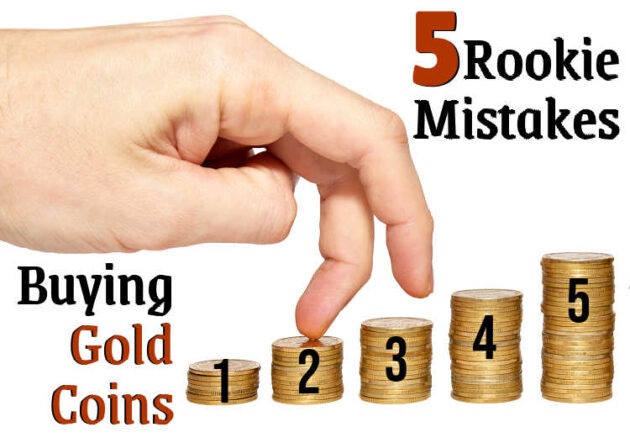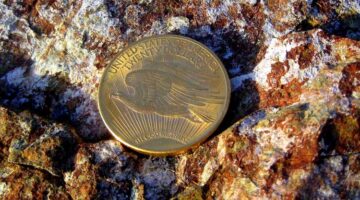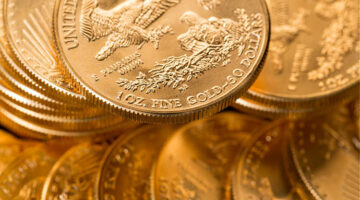Many people make mistakes when buying gold coins.

So… what are they? And how do you avoid making those same mistakes?
Some of the most common mistakes when you buy gold coins can cost you tons of money!
There are also some gold buying mistakes that may not set you back in the pocketbook, but might cause frustration or disillusionment when you’re trying to invest in gold or build a collection of gold coins.
Here are the top 5 gold coin buying mistakes you should avoid…
#1 – Paying More For Gold Coins Than You Should

Let’s start off with a quick fact: Unless you’re a coin dealer, a coin wholesaler, or you’re buying damaged or otherwise undesirable gold coins, you will generally not be able to buy gold coins at spot price!
So, there’s that…
Having said that, you shouldn’t pay more for gold coins than you need to, either.
How do you find out the value of gold coins before buying — so you’ll know how much you should pay?
Well, one of the first things you need to determine is the current gold price. While you may not be able to buy gold coins at their melt value, it’s still important to know what the price of gold is today — so you can get a baseline figure in your head.
From there, you’ll want to check out gold coin values. That way you’ll know the prices of the gold coins you want to buy. Some gold coin prices change quickly — especially if the values of the gold coins you want to buy are largely dictated by their prevailing bullion value.
The problem for some people is they buy gold coins without ever checking the value of the gold coins they wish to purchase ahead of time. This often results in the collector (or investor) paying much more than they really needed to for the coins they wanted to buy.
Some will pay hundreds, even thousands of dollars more than they should without ever flinching because they assume the prices they’re being charged are fair. But this is how many people — particularly new collectors, inexperienced investors, and the elderly — are ripped off.
The bottom line… A little research on current gold coin prices is well worth the effort. It may save you tons of money!
#2 – Mistakenly Buying Gold-Plated Coins

There are many gold-plated coins masquerading as real gold coins. There are also plenty of promoters who are selling items that may appear to be solid gold coins but, in fact, aren’t.
Some of these gold-plated coins are marketed as replicas through TV or magazine advertisements. Many of these advertised pieces copy the popular Saint-Gaudens and gold Buffalo designs. And pieces with these motifs often sell for, say, $19.99 (or a similar price).
While seasoned coin collectors can spot these gold-plated copies from a mile away, there are plenty of new collectors (or those who simply want to buy a gold coin) who mistakenly think that these gold-plated coins are solid gold.
Legitimate advertisers will offer such pieces with a small disclaimer stating the piece being sold is simply a gold-plated replica bearing the word “COPY” somewhere on the item. However, a lot of folks don’t catch this and think they’re getting a cheap gold coin for sale at a bargain price!
The bottom line is… If you want artistic gold-plated rounds made from base metals like copper or tungsten, then by all means buy them. But if you’re looking for real, solid gold coins for your collection or investment portfolio, then you’ll need to buy them from a reputable coin dealer.
#3 – Buying Fake Gold Coins
This isn’t the same as buying gold-plated coins that are advertised as such. We’re talking about mistakenly buying gold coins that were sold as being authentic but in fact aren’t.
One of the fastest-growing areas of coin fraud and counterfeits has to do with unscrupulous people intentionally marketing fake gold coins as though they are real gold coins. People can lose their money really quickly when they’re buying gold coins in parking lot deals arranged through online swap meets or deceptive internet sales.
Fake gold coins are not always easy to spot. Some fake coins look very close to the real thing!
You’ll often find fake gold coins in these places:
- Magazine advertisements placed by disreputable coin dealers
- eBay auctions
- Flea markets
- TV infomercials
Here are some tips for buying gold coins — so you don’t get stuck with fake gold coins:
- Buy only certified gold coins authenticated by 3rd-party coin graders.
- Make sure the coin dealer you buy gold coins from has a return policy.
- Buy gold coins from reputable coin dealers.
- Buy gold coins from legitimate investment brokers.
- Know how to buy gold coins on eBay so you don’t get ripped off.
The bottom line… Be wary about buying any gold coins in an online swap meet or buying gold coins for an exceptionally good deal. If you have a bad feeling about a gold coin transaction you’re about to embark on, trust your gut instinct. If you want real gold coins, buy them for a fair price from a legitimate gold coin dealer — not through some classified ad.
#4 – Getting Caught Up In Hype About Gold Prices

A lot of people selling gold coins have been saying for years that “gold prices are going to $3,000” or “gold prices will hit $5,000” — or other similarly bold predictions.
Such predictions may not be wrong. It’s possible that gold prices will be $3,000, $5,000, or $10,000 an ounce in the years ahead. And nobody is to say this can’t even happen tomorrow, next week, next month, or in a few months.
But folks who tend to have anxiety about supply shortages, a monetary system collapse, or other dire things like that will hear stuff like this and believe if they don’t buy gold coins today then they will miss out on some huge gold price spike that’s supposedly just around the corner!
It’s OK to invest some money in gold coins, and it may be prudent to buy some soon if such a purchase is within your budget. In fact, for those who want to diversify their investment portfolio, it’s recommended to buy gold coins.
However, it’s important to take gold price predictions with a grain of salt.
Absolutely nobody has a crystal ball when it comes to what the price of gold will be in 5 or 10 years, let alone tomorrow. And if there’s some type of unforeseen terrible global tragedy going on that causes gold prices to suddenly surge beyond $5,000 or $10,000 overnight, chances are you’re going to need fresh bread, clean water, and safe shelter to get you through — not gold coins or chunks of precious metal.
The bottom line is this… Invest in gold coins if you want to improve your odds of having a robust investment portfolio. But be careful buying expensive gold coins based on any specific gold price predictions — especially those that have (so far) been going unfulfilled for many years now.
#5 – Believing That Gold Coins Always Go Up In Value

This is one of the most common mistakes people make when buying gold coins.
Many have a misconception about the value of gold (or gold coin values) that leads them to believe gold prices will always go up and up and up. This simply isn’t true.
Let’s look at 40 years of gold prices — 1980 to 2020.
During that time, gold prices hit record highs on at least 3 occasions, only to sharply drop right after:
- Gold prices in 1980 hit $850.
- Gold prices reached $1,850 in 2012.
- Gold prices topped $2,060 in 2020.
Granted, each successive record tops the previous year by a decent margin. But if you’re looking at inflation-adjusted gold prices, the price of gold has never eclipsed its 1980 peak. It has come close. But, technically, people who bought gold in 1980 when prices were at their then-all-time high would’ve likely lost their money over the years since (at least when directly comparing the value of gold against inflation).
So, what’s the purpose in buying gold coins if there’s no guaranteed profit?
Of course there’s the collector angle… Having a nice set of gold coins isn’t just about the gold inside the coins but also their rarity, beauty, and collector appeal.
Ultimately, gold really shouldn’t be viewed as an investment in the traditional sense — that is to say something that will necessarily go up in value. Rather, gold should be thought of as a protection against economic bad times.
Even if the value of the dollar goes down, the value of gold should still stick around — because people look to this precious yellow metal as something greater than just its worth as measured by any one nation’s currency. Gold has many uses and will always have value for those purposes and perhaps many others that are currently unknown. Plus, humankind has valued gold for more than 5,000 years. It has outlived virtually every world currency that ever existed. And it will probably always have special importance to human civilization.
The bottom line… Gold may not always go up in value year after year, but it has a staying power that will be there even when the American economy or the world economy is having a bad day or two. And you can take that to the bank!
I hope you’ve found the above gold buying mistakes helpful in your journey to research and buy gold coins.
In addition to avoiding those top 5 rookie mistakes buying gold coins, you might find our other gold coin buying articles helpful:
- 5 Cheap Gold Coins For Collectors And Investors
- Why Does It Cost So Much To Buy Gold US Mint Coins?
- 3 Reasons To Buy Gold Coins Now + 3 Reasons To Wait
- Current Gold Dollar Coin Values
- 5 Legit Ways To Buy Silver & Gold Coins At Or Below Spot Price
I’m the Coin Editor here at TheFunTimesGuide. My love for coins began when I was 11 years old. I primarily collect and study U.S. coins produced during the 20th century. I’m a member of the American Numismatic Association (ANA) and the Numismatic Literary Guild (NLG) and have won multiple awards from the NLG for my work as a coin journalist. I’m also the editor at the Florida United Numismatists Club (FUN Topics magazine), and author of Images of America: The United States Mint in Philadelphia (a book that explores the colorful history of the Philadelphia Mint). I’ve contributed hundreds of articles for various coin publications including COINage, The Numismatist, Numismatic News, Coin Dealer Newsletter, Coin Values, and CoinWeek. I’ve authored nearly 1,000 articles here at The Fun Times Guide to Coins (many of them with over 50K shares), and I welcome your coin questions in the comments below!

